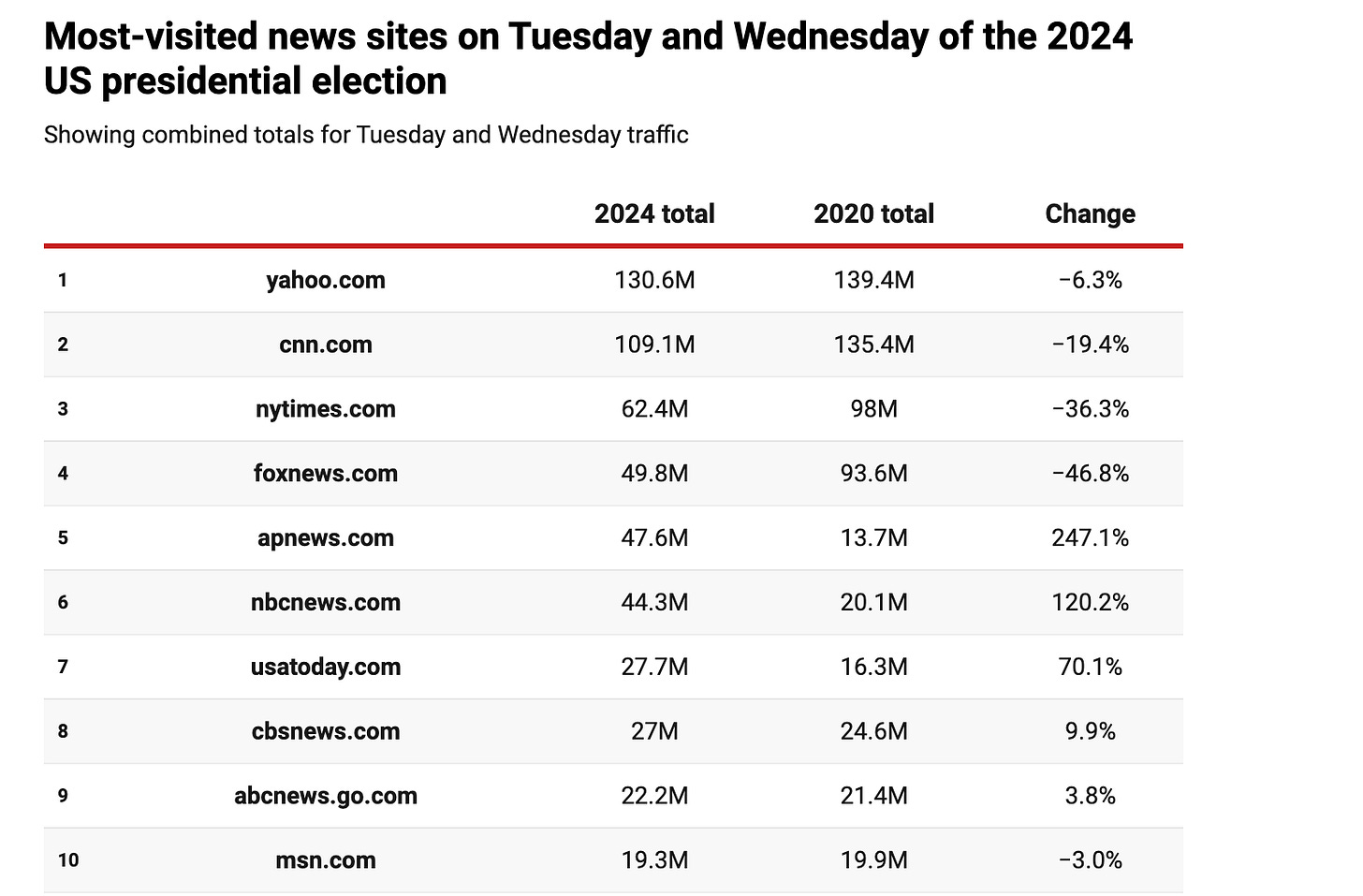Good morning.
It’s been a somewhat hectic week at work.
That’s usually the case when there are big changes at your workplace. People have more thoughts on them that they’ve shared in case you were curious.
Because of that, I don’t have one fully thought through main theme today. Instead I’ve got two half-baked things that are on my mind.
Let’s get to them.
Half-baked theme #1
Earlier this week on LinkedIn, I was fed a post from a month ago that was written by Saeed Ahmed who is the VP of news for digital platforms at the Associated Press.
The post used charts from a Press Gazette piece looking at the changes in traffic on election day between 2020 and 2024 for different news publishers. The post Ahmed shared was this one.
Ahmed called this out because the AP saw their 2024 election day traffic increase by over 200 percent vs. 2020. That’s an achievement for any publication right now.
The Press Gazette also presented the data with the total visits figures included.
The AP’s starting number of visits in 2020 was lower and they still didn't have as much traffic as CNN or the New York Times or even Yahoo in 2024.
But there’s something here that I think is worth watching, and that’s the idea of straight news reporting becoming potentially more attractive as people tire of media personalities, particularly more left-leaning personalities.
As covered before, conservative media seems to be the most influential at this point in time. And people seem to be tuning out broadcast news, which for the most part isn’t even really news anymore but entertainment and opinion. A weird, antiquated format that has awkwardly started to take on the qualities that people look for in podcasts: confirmation bias.
The question is: Do people really want actual reporting? And will they pay for it?
Substack saw the largest percentage increase in visitors in 2024 vs. the 2020 election. And people aren’t subscribing to and reading Substacks for reporting.
They’re doing it to get opinions and to make sense of the news from people who create content they find value in.
That’s a different thing from news.
Half baked theme #2
“Viewers globally streamed over 1 billion hours of content daily on their TVs, with creators right here with us — bringing their A-game to the big screen….The share of videos uploaded to YouTube in 4K is up by over 35% year over year, as creators prioritize high-quality viewing experiences that truly shine on TV screens. And that investment is paying off: the number of creators making a majority of their revenue from TV is up more than 30% year over year.”
That quote is from an end of year summary on YouTube’s blog highlighting how viewing habits of YouTube video are shifting from desktops, phones, and tablets to people’s living room smart TVs.
As I wrote earlier this year, your TV is really just a mechanism to watch YouTube now and it seems that more and more people are going to be doing that. It also seems that’s where advertisers want to spend more of their money.
That’s going to be a challenge for news and other lifestyle media outlets, because people and advertisers don’t seem to want to spend time or money on their site surfaces much anymore. And video is expensive.
But there might be opportunities on smart TVs. For instance, my company has FAST channels but we don’t talk about them probably as much as we should.
I mean, when David Letterman is spinning up his own FAST channel to air classic clips and other content alongside commentary, you’ve got to ask yourself what game you’re even playing anymore.
(For the record, I fucking LOVE David Letterman and Jason Zinoman’s biography of him and think that the Chris Elliott characters on Letterman are the pinnacle of late night comedy—maybe tied with the SlipNutz from Conan—but I don’t think of Letterman as a digital media strategist.)
If people are spending more time watching all kinds of video programming on their smart TVs or scrolling through passive entertainment apps (IG, TikTok) then what role does a website have now?
One good quote about Notes
“I do not wish this platform to be different. This is the nature of the platform. All of the debate club kids and irritating pedantry and extremely annoying anti-institutional stances are, well, a feature, not a bug, for the user base. And I understand that. What I have come to understand over the last couple of weeks in particular is that it’s a space that I actually do not enjoy very much. As my parents used to say, ‘If you don’t like it, leave.’”
This quote is from the novelist Brandon Taylor about why he dislikes Substack Notes. I agree with everything Taylor says. And he gives good advice here in particular. Notes started out as a LinkedIn for writers that then morphed into a weird marketing community and now it's become a place for writers to complain about other writers or about why people aren’t reading their writing as much as other writers.
More links
The future of TikTok in the United States may really be in the balance. Too bad lots of people are using it to shop and that plenty of media companies are investing in it. Maybe they’ll give people enough cash to have more people sign-up so they can survive?
Oliver Darcy talked to Vox CEO Jim Bankoff about some of the new business initiatives Vox has rolled out this year.
BuzzFeed sold off First We Feast, the creator of Hot Ones, to get a cash infusion to pay their investors.
Dylan Byers talked to Troy Young about the current state and the future of media. I highly recommend listening to this one.
Double Dylan Byers alert! He also talked to Barry Diller in another fascinating conversation. The Grill Room has been on fire out of the gate.
Axios’s Kerry Flynn and Sara Fischer report that Complex is relaunching their print magazine. Remember: print is not back. It has a place in the right business model but it is not back.
The People vs. Algorithms guys talked about the interfaces that are going to dominate the internet and maybe our cars. This one got pretty lively.
Jason Koebler of 404 Media wrote a nice LinkedIn post about 404’s achievements and also how his perception of audience has changed since launching the company.
Sara Fischer had a news item about how the team that started Parse.ly (the tool that nearly all media organizations use to look at real time traffic but which has a lot of limits in the new media landscape) are working on a new company to incorporate AI assistant products into newsrooms.
This was a nice little case study of how The Telegraph uses comments on articles to create new content and how that content then feeds into further engagement from their readers.






